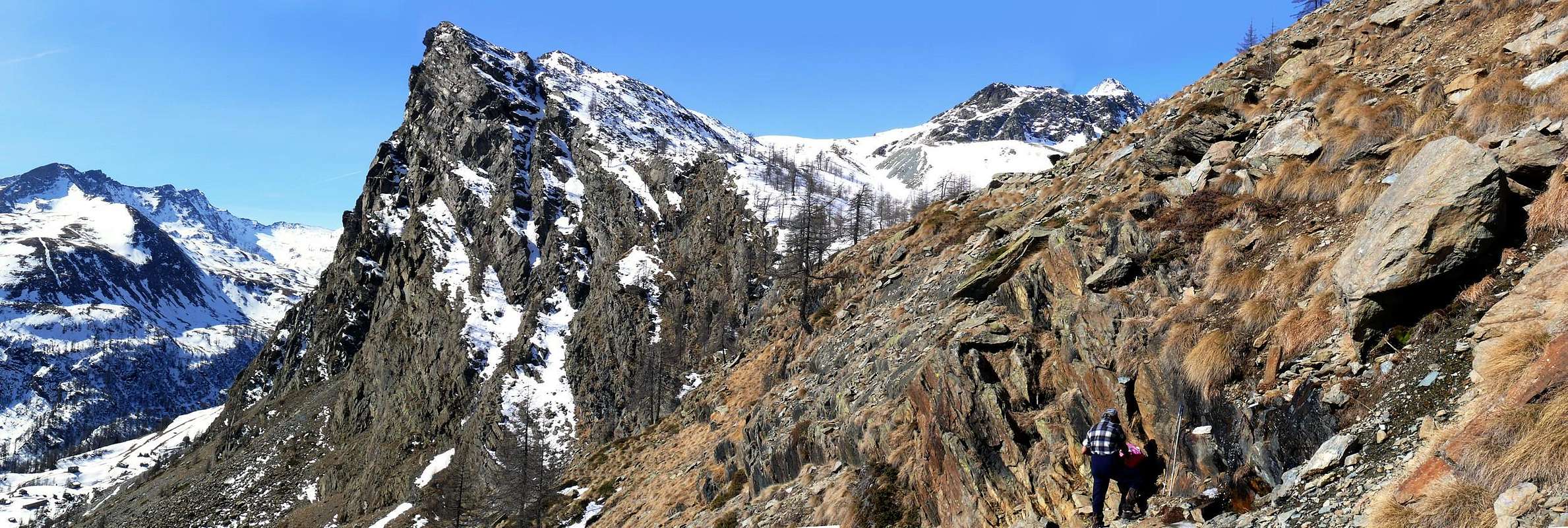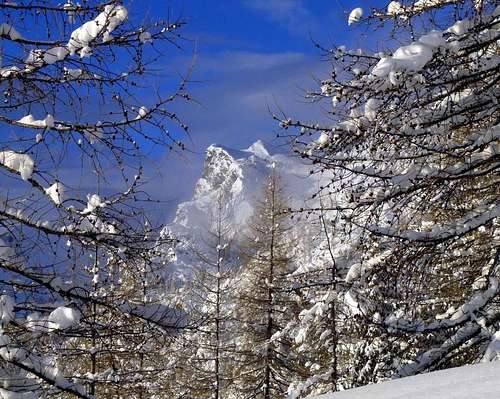-
 7109 Hits
7109 Hits
-
 86.85% Score
86.85% Score
-
 23 Votes
23 Votes
|
|
Mountain/Rock |
|---|---|
|
|
45.62240°N / 7.57627°E |
|
|
Mountaineering |
|
|
7930 ft / 2417 m |
|
|
Overview

Per quanto soggiogata dalle due ben più elevate piramidi del Mont Delà (3.139 m) e del Mont Mont Glacier (3.186 m, vetta più alta dell'intero sottogruppo al quale dà il nome), questa particolare cima, allungata per oltre un kilometro sull'asse Est/Ovest, diventa rappresentativa per il Comune di Champorcher, essendo ben in vista già sin davanzo all'entrata nel villaggio capoluogo dell'omonima valle. Dovrebbesi scrivere non del Bec Raty, bensì dei Becs Raty al plurale, poiché l'intera montagna risulta formata da un Antecima Est e da tre punte (Est, Centrale ed Ovest) disposte perfettamente in linea sullo stesso crinale spartiacque, divisorio la valle centrale dai Valloni di Sapy o Chapy-Raty-Bocon ad Oriente, nonché da quello del Giasset ad Occidente alle pendici di una conca racchiusa tra il Mont Glacier e la Gran Rossa (2.866 m). Lungo entrambi i medesimi può avvenire la salita con analoga partenza sempre sulla Strada poderale sterrata o Strada Reale dei Savoia per Dondena (2.100 m 10 Km circa dal capoluogo, con traffico aperto per gli automezzi), ma alquanto distanziata da diversi Kilometri. Il suo versante alpinisticamente più interessante è certamente il Meridionale, precipitante sulle pietraie della sottostante suddetta strada con pareti alte da 200 a 300 metri e sulle quali sono state tracciate delle belle vie di roccia, attraibili ed attraenti anche per il fattore legato alla brevissima marcia di avvicinamento. Su queste si riscontrano tratti disomogenei con roccia buona alternata con settori molto più "rotti" ed anche con erba e terriccio, a seconda delle vie scelte (diversi spit in sito). Sul versante opposto, ovvero Settentrionale, pendii alquanto meno ripidi e compositi da placche rocciose più adagiate e rotte, alternate a tratti erboso-detritici e blocchi, rendono facile, se non elementare, la salita; la traversata in cresta, nell'uno o nell'altro verso, invece presenta alcuni brevi passaggi interessanti e divertenti, con grande esposizione a Sud. Gita escursionistica facile, diventa più impegnativa se compiuta d'inverno per mezzo di sci o delle racchette da neve; permette inoltre diverse "liaisons", tramite fantasiosa scelta personale, con le vicine Sommità della Gran Rossa, del Bocon d'Amon e dei più "piccini" Mont Ros e Bec Barmasse, minuscoli pulpiti-promontorio, affiancantili ad Oriente costituendone la logica prosecuzione dal punto di vista geomorfologico. Viste ristrette, ridotte e locali, visto il più elevato circondario, che si posano sul trio Mont Moussaillon, Delà e Glacier, verso Nordovest, e sulla bella piramide della Rosa dei Banchi (3.164 m seconda vetta della Valle di Champorcher), frontalmente e dirimpetto a Sud.
First Ascents
- First on the Summit: Unknown.
- In Winter: Unknown.
Getting There
BY CAR:- From Torino, Milano, etc: Motorway A5. Exit Pont Saint Martin for then to continue on SS.26 toward Hone Bard.
- From Switzerland: through the Grand Saint Bernard Tunnel or the namesake pass. Drive to Aosta, Fénis Village or Verrès and Hone Bard.
- From France: through Mont Blanc Tunnel or Petit Saint Bernard Pass. It isn't necessary to take Motorway A5: you can drive on SS.26, in the direction of Aosta and Fénis Village or Verrès and Hone Bard.
- Aeroporto "Corrado Gex" Saint Christophe (Aosta).
Approach
From the exit of Motorway to Pont Saint Martin reach, through a Main Road, Donnas Commune: immediately after the village (interesting view on the adjoining road to console adorned by a beautiful Roman arc). Some hundred meters, to the of near of I approach Dora Baltea Stream, bridge of the to cross they govern the indication Champorcher; to follow the Regional Road for this place. Of to go beyond the of Commune Pont Bozet the to reach the Village-Chief town called Chateau (= Castle; immediately is found the indication to Fraction Petit Mont Blanc. Road of this to follow, not too much great, for different km; the first part of the same one is in asphalt for then to continue in beaten earth. Usually the conditions of this second are enough good and however it are worthwhile to ask for information in the zone, considering that lately works of government maintenance are performed. Road of this to continue, the ancient one of they govern of coincident Real Road, octave flute than to the of until and underlying the Dondena little Village, near the Torrent Ayasse (2.100 meters; at the end a signal it prevents the traffic, immediately in the narrow as well as limited parking lot; poster signallers in cover of bench of an in wood; great crowd confusion of relative of and; a feet 1h'30/2h'00 from the term of the asphalted road).Route A
From the Giasset's Vallon, passing through the homonym loch and "colletto": To continue for brief I treat with the road in earth that, gone beyond a second smaller parking lot, continuous toward North reaching the Alp of the Giasset, where it finishes (2.057m); to continue with the path n° 9C more toward Northeast reaching the homonym and small lake (2.308m; T; 0h'30). From this, leaving to the left (North) a slender trace along the frontally floor Walloon that is addressed toward the two Necks of the Gran Rossa, to decidedly turn to East and, with steep run, to reach the small hill impending, called on the spot "Little Collar of the Giasset" (2.370m around); from the pass, with brief and easy slope toward South, to reach through a small path the Western Bec Raty, the most elevated of the three (2.417m; 0h'45 from the Lake Giasset; 1h'30 in total from Dondena Village). To cross to the Central Bec Raty (2.399m, second elevation in height: very evident for his form to roof above the great jump toward South) to follow toward East the crest watershed and, with run sure and beautiful views on the underlying Wall South, to reach it after having overcome on the left (North) to small, brief as well as amusing passage "of strength" (4/5 meters; Ii°/II°+; 0h'15). The third Bec or Oriental (2.382m, I.G.M. = Italian Institute Geographic Military), always followed by a lower East Great Shoulder, it is found more distant and it asks for a greater appointment introducing some most complex characteristics, with some most complicated passages, difficult and rather more statements, always on the right.Route B
From the Vallone of the Raty, transiting for the homonym lake and "Collar of the Giasset": from the Real Road/High route n° 2, after the rectilinear long coming from the Alp-Village La Cort (1.880m around), to reach a first alternative with the descriptive poster "Raty"; abandoned the Real Road, to continue first toward Northeast and then Northwest through the road in earth, here coincident with the path-mule-track 9C, that salt through the wood. To reach so the Alp Sapy (1.979m), where the in soil road "poderale" it has end; to continue with the same path, but more moved toward North (beautiful small fountain gushed out from the rock; splendid sights, little by little that it rises us, on the East Wall of the Great Shoulder of the Oriental Bec Raty), going beyond on the left (West) a short rocky band, at the base of Southerner Slope of Bec Barmasse. You enters therefore the impending and mostly level Walloon of the real Raty, crossing the homonym Torrent, really under the reddish and rocky Wall I Know about the Bec Barmasse (2.296m); forded few over another branch of the same stream, the Pasture it is reached Raty Dèsot (= Lower; 2.241m) and, I immediately approach, the intersection with the path coming from the Lacke Vernouille (2.145m) and from the Alps Raty de Fort (2.229m) and Raty (2.274m). Immediately later, easily with the same, the beautiful Lake is reached to Raty (2.283m) with its vast banks, really proper to a good person "siesta" gastronomy (1h'00); from the lake, revolved to the left (South) its Southern bank, with a half dozen of hairpin bends and an enough long diagonal toward West the is reached "Collar of the Giasset", from where to the preceding route (1h'30/1h'40).Difficulty
The route can be considered from E/F and EE/A/F+ for the Central and Eastern Summits.Equipment
For Excursion and ski or snowshoes, in presence of strong snow.Campings
Remember that free camping is forbidden (except for emergency reasons, over 2.500m, from darkness until dawn).Mountain Conditions
- You can get meteo information at the official site of the Regione Valle d'Aosta:
- Valle d'Aosta Meteo
Webcam
- WEBCAM on Aosta Valley:
- Webcam
Books and Maps
BOOKS:- "Guida delle Alpi Occidentali" di Giovanni Bobba e Luigi Vaccarone C.A.I. Sezione di Torino Volume II (parte II), 25 Maggio 1896.
- "Guida dei Monti d'Italia – Emilius Rosa dei Banchi-Parco del Mont Avic" di Giulio Berutto e Lino Fornelli - Club Alpino Italiano/Touring Club Italiano, Marzo 2005.
- "Diari Alpinistici" di Osvaldo Cardellina e Indice Generale accompagnato da Schedario Relazioni Ascensioni 1964-2019 (inediti).
- Ingenia "Parco Naturale del Mont Avic" Carta dei sentieri 1:25.000.
- Enrico Editori Ivrea "Carta turistica del Canavese" 1:100.000
- Enrico Editore Ivrea-Aosta "Gruppo del Gran Paradiso" 1:50.000.
- L'Escursionista editore "Valle di Champorcher Parco Mont Avic" Carta dei Sentieri (11) 1:25.000.
- L'Escursionista "Valle di Cogne" Carta dei Sentieri 1:25.000.
Important Information
- REGIONE AUTONOMA VALLE D'AOSTA the official site.
- FONDAZIONE MONTAGNA SICURA Villa Cameron, località Villard de la Palud n° 1 Courmayeur (AO) Tel: 39 0165 897602 - Fax: 39 0165 897647.
- A.I.NE.VA. (Associazione Interregionale Neve e Valanghe).
Useful Numbers
- Protezione Civile Valdostana località Aeroporto n° 7/A Saint Christophe (Ao) Tel. 0165-238222.
- Bollettino Meteo (weather info) Tel. 0165-44113.
- Unità Operativa di Soccorso Sanitario Tel. 118.
























